Melting Snow at Broken Bridge
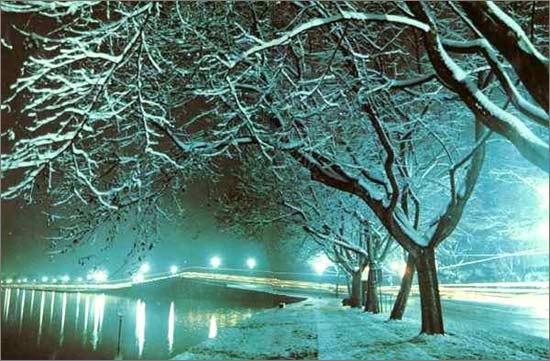
The snow scene of the west lake is enjoyed very high praise by people, especially the view of “melting snow at broken bridge”. Why it is called as “melting snow on the broken bridge”, there are different sayings. One of them is that it snows almost every winter in Hangzhou and when the sun comes out after snowfall, the snow on the sunny side of the bridge melts first, while the snow on the shady side still lingers. Looked at a distance or from a nearby hill, the bridge appears to be broken. It is a favorite stopover for you. Especially on fine winter days after a snow, you may stand on the bridge to feast your eyes on the snow scene far and near. Distant hills, clad in white, grow more enchanting. The famous Chinese folk story “The Tale of White Snake” brings the broken bridge some romance.
Viewing Fish at Flower Harbor
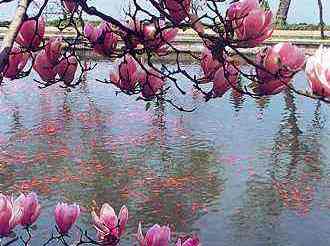
Started in Southern Song, this beauty spot located at the food of Huajia Hill on the west bank of the West Lake initially. It used to be a private garden villa which was belong to a palace eunuch named Lu Yunsheng. It was listed as one of the “Ten Views of West Lake” because of its beautiful scene. In the Qing Dynasty, Emperor Kangxi rebuilt the garden, which lies between Western Hill and Su Causeway. The major expansion projects after 1952 has turned the former garden into the grand park, covering an area of 50 hectares. The big fish pond keeps a few thousands of red carps. Bending over the rails of the bridge and watching the red carps noisily scrambling for food thrown to them is a delicious experience. The bank of the pond is planted with a rich variety of trees and flower, the reflection of which in the water is fantastic.
Leifeng Pagoda in Evening Glow
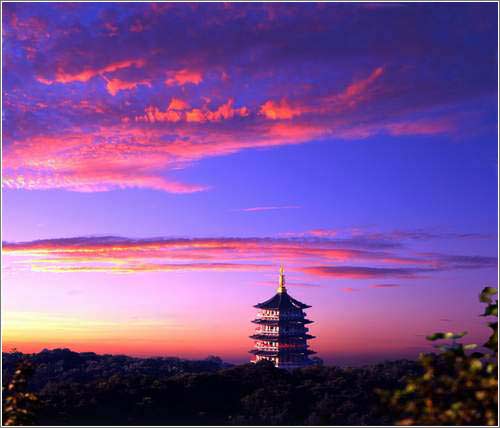
Leifeng Pagoda, on the Evening Glow Hill situated on the south shore of the West Lake, was erected in celebration of the son his favorite concubine, Huang Fei, gave birth to. The 7 storied pagoda was a storied pavilion type structure, built of brick and wood. In the ancient time, Leifeng Pagoda and Baochu Pagoda stood far apart facing each other. Leifeng Pagoda appeared to be an old gentleman, but Baochu Pagoda appeared to be a beauty. When the sun was setting, the pagoda bathed in the evening glow looked radiantly beautiful. It was therefore named as “Leifeng Pagoda in Evening Glow”. In Ming Dynasty, the pagoda was fired by the Japanese bandits and collapsed at last on September, 25 1924 by the custom of local people to take a brick from its lower stories as a talisman or souvenir.
Evening Bell Ringing at Nanping Hill
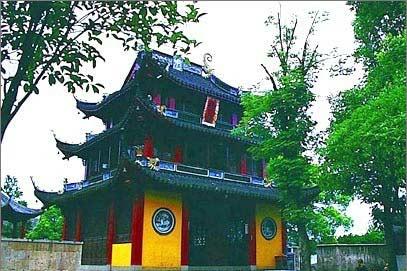
Evening Bell Ringing at Nanping Hill, it is one of the “Ten Views of West Lake” with the longest history. In the Northern Song Dynasty, a distinguished artist, Zhang Zeduan, did a painting entitled “Evening Bell Ringing at Nanping Hill”. It is not as famous as the Riverside Scene at Qingming Festival which also was done by him. Nanpin Hill lies along the south bank of the West Lake, less than 100 meters high, but extends as long as over 1000 meters. It features the odd-shaped rocks and the green woods. Nanpin Hill offers different views due to the different weather. In fine days, the green woods over the hill grow more enchanting. In rainy days, the hill partially covered with clouds and fog creates a beautiful scene: the hill looks like dance trippingly.
In 972 A.D. a famous temple, named as “Xingjiao Temple”was built on the Nanpin Hill. After that, a few more small temples were built around it. Therefore, Nanpin Hill was locally called as “Buddhism Kingdom Hill”. Formed of limestone, the Nanping Hill contains lots of caves and cavities. The shape of the hill is just like a painted screen. Therefore, when the bell was rung in the evening, its sonorous sound echoed through the caves and cavities, even reached as far as the other shore of the West Lake. And then the Ge Hill locating there sent back a big echo over the lake.
"Autumn Moon over the Clam Lake
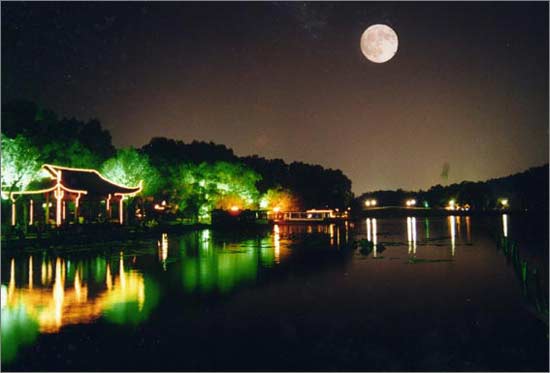
Situated at the west end of the Bai Causeway, it affords the broadest view of the West Lake. Furthermore, it is a nice garden with delicate pavilions, zigzag little bridges, odd-shaped rockery and a rich variety of plants. On the night of Middle Autumn Festival, it would be no better place along the lake side to enjoy a beautiful full moon here. While sitting on the terrace to enjoy the middle autumn moon, you would be really impressed by seeing the reflections on the water, the cloud and the moon mingling with each other, the moonlight and the lake light enhancing each other’s beauty. A famous couplet is dedicated to this scene: “The vast, calm lake is bright as a mirror, the year-round moon is the brightest in the autumn.”
Twin Peaks Piercing the Cloud
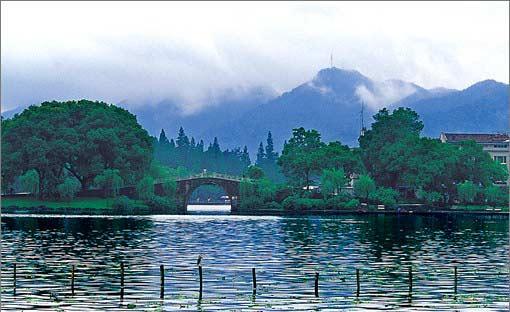
Twin peaks are the Northern Peak and Southern Peak. One locates southwest to the West Lake and the other locates northwest west. Northern Peak is with an elevation of 256.9 meters, Southern Peak is with an elevation of 355 meters. The two peaks face each other at a distance of more than 5 kilometers. On a drizzly day in spring or autumn, visitors may find a spectacular view of the two peaks while they look up from the Hongchun Bridge. It seems as if an enchanting landscape painting was hanging before them with the peaks disappearing and appearing amidst drifting clouds. Therefore, it has become known as Twin Peaks Piercing the Cloud, one of the “Ten Views of West Lake”.
Orioles Singing in the Willows

The park is a part of the Southern Song Dynasty’s Royal Garden before. After liberation, the park covers a total area of 300 areas by renovation and enlarging. It is a wonderful leisure place with the green willow leaves and orioles warbling. In the spring, the vernal breezes stroke the willows, their branches sway gently, bending over to kiss the rippling water. Walk in the garden, the orioles singing, the willows dancing, what a wonderful time it is. Now the park is combined by three gardens: Orioles Singing Garden, Friendship Garden and Collected Scenery Garden.
The eastern south of the Garden is served as a traditional public entertainment site. An open stage is built there. It is a good place for Hangzhou citizens and tourists to enjoy themselves. In the Summer and Autumn, the garden is served as an “evening garden”. The lanterns exhibition, the traditional folk performance and cinema attract a lot of visitors every night.
The park locates on the Nianshan Road of West Lake District, now is one of the views along the south bank of the West Lake.
Three Pools Mirroring the Moon
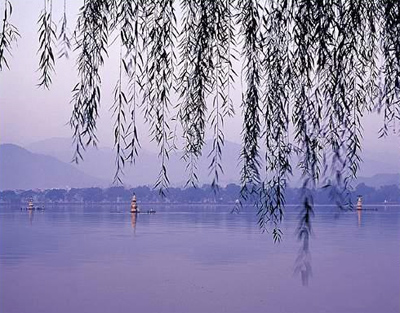
The islet is one of the three islands in West Lake, it is named as “Lesser Yingzhou” which means the “Fairy Islet”. Among the three islet in the lake, the Lesser Yingzhou is the biggest and finest one. And it is recommended as “The best scenic spot in West Lake”.
The islet covers an area of 7 hectares including the water surface and features “a lake within an island and an island within a lake”. The wonderful garden design made this islet very unique among the ten top views.
This island was built in 1607 with dredges from the lake to create a lake within a lake initially. Afterwards, three small gourd- shaped pagodas were built in the south lake of the islet called “three pools”. At the beginning of Qing Dynasty, a general named Peng Yulin, after retiring from his official post, built for himself a garden villa on the island and then zigzag bridges, pavilions were added.
After you go ashore at the port located on the north of the islet, two buildings will meet your eye firstly. Then, you will walk along the zigzag bridge which is better known as the “Nine Turn Bridge”. There are total four pavilions along this bridge including the Open Net Pavilion, Tingting Pavilion, Experor Kangxi Stele Pavilion and “Heart linking to - Heart” Pavilion.
Spring Dawn at Su Causeway
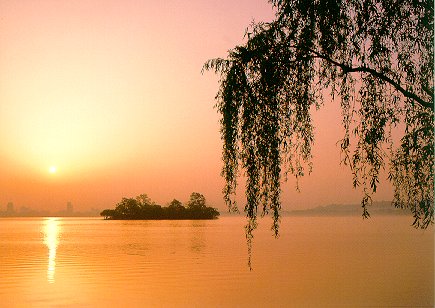
Su Causeway is as long as three kilometers. It was built of the dredges of West Lake when Su Dongpo, Northern Song Dynasty poet, organized a large scale dredging of the lake during his term as the city’s governor. Therefore, it was named as “Su Causeway”.
Walking along the causeway in spring, you will see the willows tossing among blooming peach flowers. There are six bridges along the Su Causeway offering different views. Especially after a spring rain, you may stand on the causeway and feast your eyes on the lake far and near through the willow branches.Distant view is covered by the light foggy, grow more charming. This scene was named as “Six Bridges in Misty Willows”. With this special scene, the causeway and its bridge becomes a very popular attraction.
Breeze-ruffled Lotus at Quyuan Garden
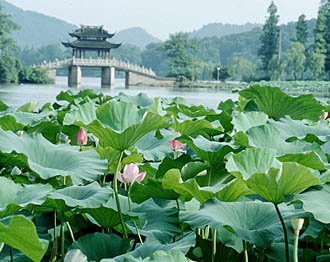
Breeze ruffled Lotus at Quyuan Garden which features in lotus ranks the 2nd of Top Ten View just after Spring Dawn at Su Causeway. In Southern Song Dynasty, Quyuan Courtyard was an official vinery which located on the bank of the West Lake beside the Hongcun Bridge on the Linyin Road where many lotus were planted. In summer breezes, the air was scented with delicate fragrance of lotus intermingled with the tasteful bouquet of wine. However, the courtyard was very much neglected and the nearby lake silted up. It became a small garden with a small pavilion, a veranda and a few lotus flowers planted in the water in front.
Started from 1983, an extension project has been under way to develop it to a huge park. Currently, the park includes five sections: Yue Lake, Bamboo Garden, Lotus Garden, Winding Garden and Lakeside Forest. Therefore it is very popular attractions for the tourists with General Yuefei’s Tomb, Guo’s Villa and Hangzhou Botanical Garden around.